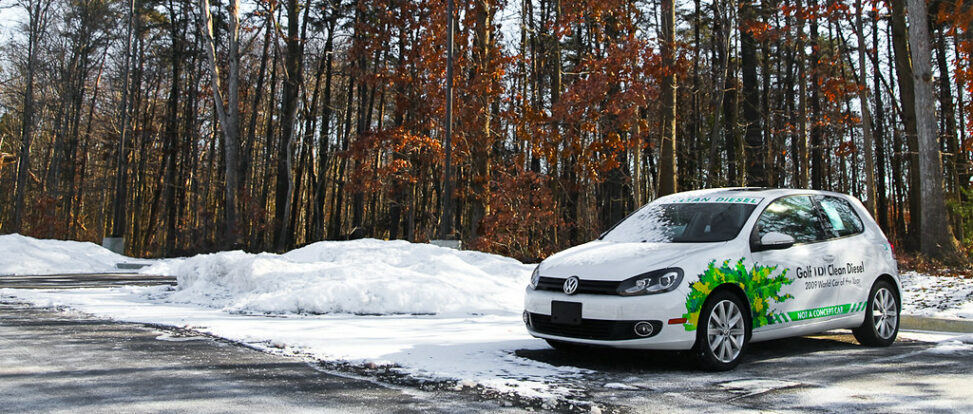Volkwagen designed the ad to showcase their range of environmentally friendly vehicles, Including electric cars and hybrid models. The focus of the campaign is on volkswagen’s dedication to sustainibility and environmental accountability. The advertisemnet is a still image and it helps capture attention and eliciting emotions, effectively communicating brand messages and strengthening brand identity. These ads can be easily shared on social media, expanding their audience and encouraging consumer engagement, establishing their importance in advertising.The scenic landscape are the main focus of the advertisement, highlighting the beauty of nature, including a lush forest, reinforcing the idea that these vehcles are going to contribute to a healthier planet,creating an inspiring narrative about the green revolution.
The white Volkswagen is positioned prominently in the front, creating a visually arresting arrangement for the advertising. A calm winter scene with snow covered mountains and a clean blue sky can be seen in the distance. The icy tones of the surrounding contrast with the cars brilliant white exterior to produce a light and welcoming look. The main subject of the image is the white Volkswagen, which claims to have lower emissions, is the main focus of the image. It stands out against the chilly background because of its elegant design, which highlights modernism and class.
The commercial presents the Volkswagen as a means of accessing breathtaking, unspoiled scenery and exudes a spirit of adventure, independence, and sustainability. The snowy backdrop of the brilliant white automobile represents adventure and purity, while the inter scenery entices visitors to picture themselves engaging in outdoor activities. The automobile is positioned prominently to serve as the main center of interest for exploration, and the cheery ambience it produces is further accentuated by strong natural lighting. In addition, the message of eco-friendly exploration is successfully conveyed using silhouettes of individual taking in the winter scenery, which accentuates themes of family unity.
Effectiveness of the image – Yes, the image successfully communicates its message to the intended audience, which is probably made up of adventures seekers and ecologically aware shoppers.
Convincing means – The commercial employs several persuasive techniques, one of which is the stark contrast between the white automobile and the snowy background, which conjures images of adventure the purity. The environmental friendliness. The message is approachable because the happy silhouettes allude to a way of life that is consistent with shared experiences and family values.
Personal Effect – The picture makes you want to explore and makes you feel restless. It makes me feel calm and excited and reminds me of the value of making sustainable decisions as well as the fun of going on outdoor activities. All in all, It strikes an emotional chord and is consistent with the ideals of exploration and environmental awareness.
Yes, it is easy to recognize the brand as Volkswagen. The vehicle’s unique appearance compliments the company’s well-established corporate identity, as does its dedication to sustainability and innovation. The Volkswagen brand is further reinforced by the employment of an adventure-themed aesthetic and a clean, modern design, which helps to make it clear that it’s a Volkswagen.
Volkswagen stunned the world on September 18, 2015, when it acknowledged to the U.S. Environmental Protection Agency (EPA) that the Clean Air Act was broken by it’s “clean diesel” vehicles. The German carmaker disclosed that during the testing, It had purposefully included a “defeat device” in its Turbocharged Direct Injection (TDI) diesel engines, which was intended to circumvent and manipulate the vehicle’s emissions control system. Reports at first suggested that only 500,000 Volkswagen diesel cars from the 2009 to 2011 model years were implicated. However, as the scandal developed, the estimated number of affected vehicles increased to 11 million globally across multiple brands. The extensive deception led to the scandal being dubbed “Diesel gate”, drawing parallels to the Watergate scandal that prompted U.S. President Richard Nixon’s resignation in 1974. The revelation not only undermined consumer trust in Volkswagen but also had severe repercussions for the company’s reputation and financial standing (Blackwelder et al. 2016).
By examining VW’s conduct through the perspective of the communicative constitution of organizations (CCO), we can see how misleading communication can result in reckless behavior that goes against marketing promises. In addition to “doing good,” the controversy highlights the significance of “avoiding bad” activities. It calls on organizations to prioritize preventing unethical activity beyond just encouraging positive contributions. In the end, the Volkswagen case is an important warning to businesses about the dangers of greenwashing and the necessity of a sincere dedication to moral behavior in order to maintain stakeholder trust and reputational integrity (Siano et al. 2017).
References
Blackwelder, Britt, Katerine Coleman, Sara Colunga-Santoyo, Jeffrey Harrison, and Danielle Wozniak. 2016. “UR Scholarship Repository Robins Case Network Robins School of Business the Volkswagen Scandal Recommended Citation.” https://scholarship.richmond.edu/cgi/viewcontent.cgi?article=1016&context=robins-case-network.
Siano, Alfonso, Agostino Vollero, Francesca Conte, and Sara Amabile. 2017. “‘More than Words’: Expanding the Taxonomy of Greenwashing after the Volkswagen Scandal.” Journal of Business Research 71 (1): 27–37. https://doi.org/10.1016/j.jbusres.2016.11.002.


Provide Feedback